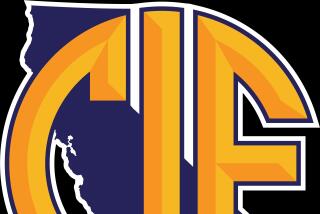CSUN Facing Prospect of Competing at Higher Level : College football: A proposal to be considered at this week’s NCAA convention requires athletic programs to be classified in the same division in all sports.
- Share via
A proposition that could dramatically alter the direction of Cal State Northridge’s football program will be on the agenda for approximately 2,400 delegates at the NCAA’s annual convention that begins Monday in Nashville, Tenn.
Proposition 53 would require an NCAA member school’s athletic program to be classified in the same division in all sports.
“They are saying, why should Northridge or Santa Clara or Sacramento State or Southern Utah State or St. Mary’s be allowed to compete (in) Division II in football and Division I in everything else,” Northridge Athletic Director Bob Hiegert said.
“Division I is saying, ‘If you are with us, you’re with us,’ and Division II and III are saying, ‘We’re not allowed to move up, so why should you come down.’ ”
If Proposition 53 passes, it will become effective in the fall of 1993.
At that time, the Division II Western Football Conference (of which CSUN is currently a member), would have to disband or change its configuration because five of its six members are or will be competing at the Division I level in all other sports by next fall.
CSUN has several alternatives, most of which depend on what happens during an expected shake-up of other conferences nationwide. One option is contingent on the fate of Proposition 54, a proposal to establish a new football division called Division I-AAA. This would allow schools that play all sports at the Division I level except football to be able to afford to play Division I football.
Proposition 54 would limit scholarships at the 1-AAA level to financial aid based on need, similar to Division III athletics. An amendment has been added to the proposal, however, that would allow scholarships at the 1-AAA level. If Proposition 54 passes without the amendment, problems could arise, some argue.
CSUN, for example, would have basketball, baseball and softball players on scholarship, but football players would be limited to need-based financial aid.
The other problem, according to Hiegert, is that there will not be enough I-AAA schools on the West Coast to fill a 10-game schedule, meaning that a team such as Northridge would be forced to complete its schedule with Division II teams.
“But they probably won’t want to play I-AAA schools because they won’t be viewed as an equalizer,” Hiegert said.
The nearest pocket of potential I-AAA schools is Dayton (Ohio) and Butler (Indiana)--there are several more on the East Coast.
“It might work on the East Coast but it wouldn’t here,” Hiegert said.
CSUN’s other options include playing Division I-A, perhaps in the Big West Conference, or playing Division I-AA, possibly in the Big Sky Conference.
A school would have to leave one of those conferences or the conference would have to expand to make room for Northridge, however.
CSUN also has the option of eliminating football or dropping all other sports to Division II.
The former option does not follow the university’s mission of growth in all areas, according to Hiegert, and the latter might make the university appear indecisive since it moved up to Division I in all sports but football this fall.
Division I-A requires a 30,000-seat stadium, which CSUN has in the planning stages as part of the University Park Project. Both Division I-A and Division I-AA require larger scholarship budgets than Northridge’s current budget.
While it is unlikely Northridge could afford the larger scholarship budget, a series of cost-cutting proposals to be considered at the convention could move CSUN, a have-not, closer to the haves.
“The cost-saving amendments, I think, will even out the playing field,” said Hiegert, who would not have to make any scholarship or coaching-staff cuts at Northridge if the cost-cutting proposals pass because the school already meets the proposed requirements.
Currently, Division I-A football programs are permitted a maximum of 95 football scholarships; I-AA has 70.
The current Northridge football program is allotted 24 scholarships, which are divided among 70 players. A potential new football conference at the I-AA level or the I-AAA level, involving a merger between the Big West and the Big Sky, has a proposed scholarship limit of 40-45.
Hiegert does not believe the expected nationwide conference shake-up will take place until after the convention because there is simply no time at the convention for conference representatives to meet.


